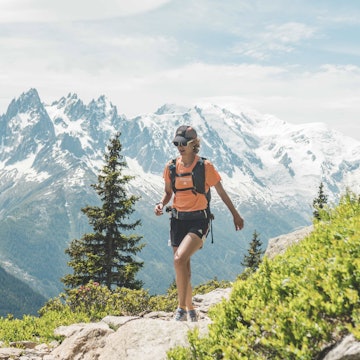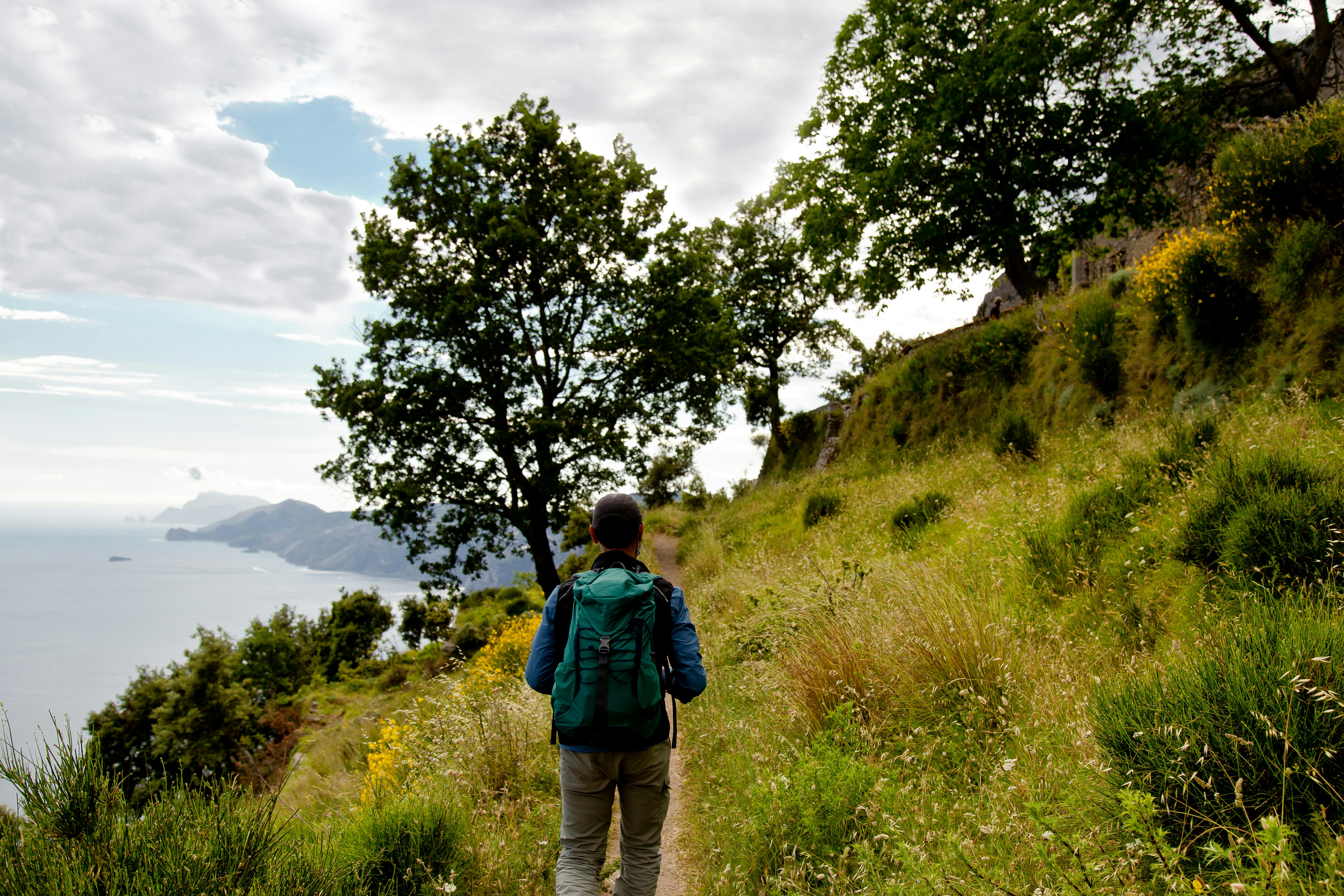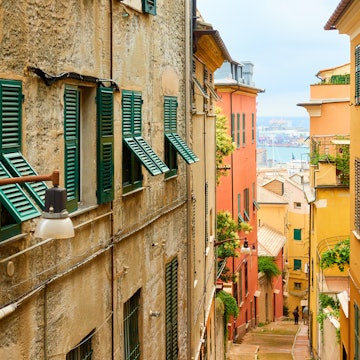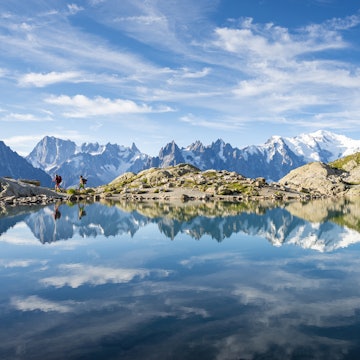

Sentiero Degli Dei (Path of the Gods) overlooking Positano and Isle of Capri. Mark Read/Lonely Planet
As soon as you arrive on Italy’s Amalfi Coast – before you’ve even uncorked your limoncello – someone will ask, “Have you done the Path of the Gods?”
The concept doesn’t sound so odd in this heavenly landscape, where each rock and body of water has a Greek origin story. Known in Italian as il Sentiero degli dei, the Path of the Gods is an immensely popular mountain trail about 7km (4.34 miles) long, at the dizzying height of 630m (2065ft) above sea level. Legend says the trench was cut into the earth by the gods as they stampeded down from heaven to save Ulysses from the mermaids’ song.
The trail sweeps through olive groves, terraces and magnificent expanses of blue sky and wine-dark sea. Peer down to see the jagged Amalfi Coast dotted with the colorful tiled domes of Praiano and Positano, the Faraglioni of Capri winking in the distance.
The Path of the Gods has entranced generations of poets and artists, including Italo Calvino and DH Lawrence. But there’s more to this sky-scraping path than sheer beauty: this odyssey, which can anywhere take from 3 to 5 hours, boasts three different starting points and various loops. It’s a medium-intensity trek, so you’ll need to be reasonably fit to tackle the sometimes-uneven terrain, steep inclines and – of course – all the stairs.
Wait – stairs? Yes. They’re why this particular journey requires a bit of planning. Here’s how to have a truly otherworldly experience on the Path of the Gods.

When’s the best time of the year to hike the Path of the Gods?
It’s never advisable to visit the Amalfi Coast during high season, which brings high prices, high temps and high stress. Ditto for the Path of the Gods: it will be unbearably hot, you’ll have to fight – literally – for a seat on public transit, and the trail itself will be crawling with hikers, blotting out that glorious sea and skyscape. Time your visit (and your hike) for the off-season or the beautiful shoulder season, in March to early June and September to October. You’ll encounter other pilgrims, but still get enough solitude to feel like the gods have created this path just for you.
Whenever you choose to hike this trail, start as early as possible to beat the worst heat and maximize winter daylight.

Should I hike the the Path of the Gods alone or with a guide?
Due to the length and rugged nature of the hike – and the fact that your cell phone will be out of range for most of the time – it’s a good idea to hike with a buddy. You can also hire an official local guide; while the trail is clearly marked, a guide can help fill in the gaps in the shrubbery. I was accompanied by Mariano Orsi, owner of Hiking Tours, who made the trail come alive by regaling me with legends and myths…while saving me from impaling myself with my hiking poles.
What should I pack to hike Path of the Gods?
Bring a lightweight rucksack; water is non-negotiable. There’s little shade, so wear a hat and a top with sleeves to prevent your backpack straps from chafing your shoulders. Trail shoes with grippy soles are a must; sunscreen and bug repellent are also handy. Make sure your phone is fully charged – although you won’t have much service, you’ll want to capture the glorious panoramas.
If starting the hike at Agerola/Bomerano, there is a hiking supply shop where you’ll be able to buy hiking clothes, snacks, water, and hiking supplies – like poles, handy on the uneven terrain.

Where should I begin to hike the Path of the Gods?
The trail – stretching from the hamlet of Agerola to Positano – has three entry points leading to a fork at Colle Serra where the trail splits into alto (high) and basso (low) routes. Your choice will determine your exit, as well as your scenery and effort level.
You can reach your starting point via car, scooter or public transit. Driving in the Amalfi Coast comes with challenges – think insane traffic, unending curves and death-defying drops to the sea below. (Also keep in mind that you’ll have to come back for your vehicle.) If you opt for public transport, note that in high season buses may be standing-room only, if you can even manage to get on. And as to whether you get to your starting point by transit or car, remember that you’ll need to find a way back. Depending on the time of year (and day), you might catch a ferry or bus. Many guides offer pick-up service.
The Agerola (Bomerano) to Nocelle or Positano route is undoubtedly the most popular, as it’s less physically taxing and encompasses the most majestic views. The full trail is about 6 km (3.72 miles) and will take roughly 3.5 hours — though the slight differences in available routes can mean things can take longer. Did we mention the stairs?
Agerola (Bomerano) > Nocelle/Positano
Drive or take the 5080 bus from Amalfi to Agerola (Bomerano) – famed for its delicious Provolone del Monaco cheese. The trail starts past the piazza. Inhale the perfume of wild rosemary and lemon groves; gaze down at the sea. Eventually, you’ll hit the fork at Colle Serra. Here, you have a few options.
Turn back to Agerola. The “half-loop.” A great option when you’re short on time and energy (and your transport is parked back at Agerola). This makes the journey 7km (4.34 miles) and will take about 4 hours depending on your speed.
Take the high road (327A). Higher inclines – 150m (492ft) higher than the low road – mean higher difficulty. After a while, the high road rejoins the low road, and you’re headed toward Nocelle, near Positano.
Take the low road (327). This easier-on-the-knees path takes you past a lovely fountain as you head towards Nocelle. There, you’ll find bathrooms and the “Lemon Point” stand selling refreshing lemon slushies. Then it’s time to tackle the 1700 (yes!) stone steps all the way down to Positano, where you will arrive in triumph like Ulysses escaping the sirens. Celebrate with an aperitivo.
Positano/Nocelle > Agerola (Bomerano)
Or you can turn the route around and start with an uphill climb – from Positano up the 1700 steps to Nocelle. Come to the fork to choose the high or low paths; when they reconverge at Colle Serra, choose your endpoint of Praiano or Agerola, then get the 5070 or 5080 bus back to Amalfi. Note that the most thrilling coastal scenery will be behind you. This route can take anywhere from 3 to 5 hours.
Praiano > Nocelle/Positano
Feeling rebellious? The path less taken starts from the town of Praiano, roughly 4km (2.5 miles) west of Agerola, where you can merge with the “low” route. Seems like a time saver? Maybe…but you’ll have to climb up nearly 2000 steps to meet those gods.
















